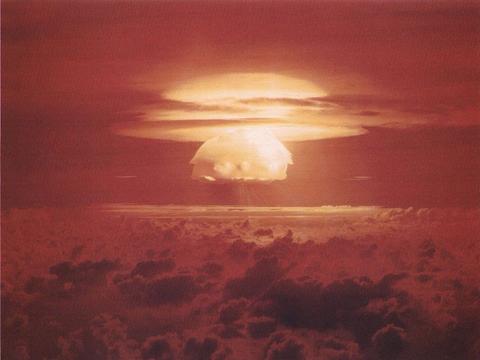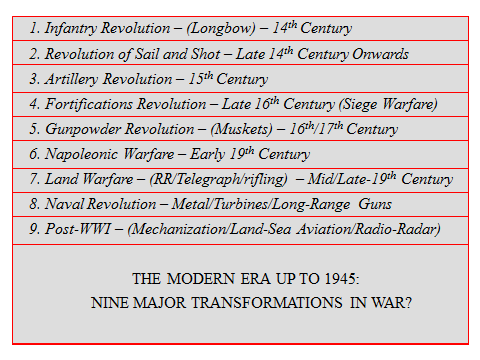
As we discussed yesterday, the rationalists’ way of characterizing war, when subsequently mixed with Napoleonic-Industrial Warfare, became synonymous in the minds of many observers with organized violence itself. The mass bloodletting and sheer entropy experienced by millions in World Wars I & II only reinforced the seeming “rightness” of seeing hard power in this way. One reason for this was that the Allies won – victory, after all, is seldom a spur for soul-searching innovation or doctrinal doubt. Second, the rationalists’ way of “packaging” war had enjoyed a long 130-year run. Given its long tenure, it was possible to forget that the Western Way of War had perhaps undergone nine major transformations (often referred to as “paradigm shifts”) since the 15th century, as the following figure shows. (Of the nine possible shifts, a strong argument can be made that the last four were mutually complementary and reinforced, rather than questioned, the rationalist critique of war popularized by Jomini and his Enlightenment Era predecessors.)

Finally, the Jominian emphasis on mass, firepower, climactic force-on-force violence, etc., that we highlighted yesterday not only worked (or so we thought), and not only made us comfortable (through long familiarity and indoctrination), it also had a compelling new reason to remain in place – i.e., a seemingly 10-foot tall Soviet bear and what would soon become its sharp-clawed Warsaw Pact cubs.
The post-1955 fear of mechanized Warsaw Pact forces flooding across the Fulda Gap fed into a broader fear in the West – a generalized fear that seized the political imagination of the United States and its NATO allies deep into the Cold War. And because the Russian threat seemed fundamental in every way, the rationalist critique of war remained dominant. There was, however, a big problem in the making; that dominant paradigm of war which so many thought was war itself was beginning to fray badly at the edges.
Soon after World War II a major and half-stealthy paradigm shift started to occur in the realm of hard power. The shift was there for all to see, at least after a while, but the massive military threat posed by the Soviet Union against Western Europe helped camouflage if not outright obscure it. As a result, what we saw unfold in the Cold War was a two-track, in-stereo process. Because the fear of a potentially devastating war in Europe was so palpable to those in the West, they continued to concentrate on (and emphasize) Napoleonic-Industrial Warfare with all its principles, lessons learned and sheer conventionality. At the same time, they also experienced a confusing parallel development – i.e., the splintering of warfare into four major directions.
First, we saw the rise of limited wars by limited means for limited ends. The Korean War initiated this era which, incidentally, I would argue we are still in today. All the “police actions” or “limited interventions” we have seen since Korea confirm an obvious point – no political leader has wanted to risk crossing over the nuclear firebreak, whether inadvertently or not, by pursuing totally “gloves off” conventional warfare against other states. In order to prevent such a blunder from happening, we have leashed the dogs of war. The only open question today is just how long the limited wars by limited means for limited ends era will last. Is it indeed permanent, as J.F.C Fuller first argued?
Second, the specter of nuclear conflict arose, or at least its theoretical possibility. Bernard Brodie, Thomas Schelling and their like-minded colleagues produced the most arcane theories (and then strategies) of hard power ever devised, but the utility of deterrence theory did not depend on actually using the “ultimate weapon.” Instead, the real political value of nukes lay in their not being used – i.e., in their latent “power to hurt,” as Schelling noted in his Arms and Influence. Nuclear weapons were thus actually not weapons, at least not in the most Alice-in-Wonderland sanctums of nuclear logic. They were actually instruments of “vicious diplomacy,” and their preferred non-use turned the Napoleonic-Industrial paradigm of war on its head, at least in the nuclear arena.
Well, if nuclear weapons and limited wars by limited means for limited ends weren’t enough to upset the apple cart, there then appeared a third major problem. When post-World War II national liberation movements began their quests for self-determination, they had a conundrum to solve – how to make weak subjects politically strong and strong colonialists politically weak. The solution was to resort to a kitbag of options that were, traditionally speaking, both “legitimate” and “illegitimate.” The latter included insurgencies, asymmetric wars, civil wars, and/or just plain “sloppy” irregular wars. The Algerian Civil War (1954-1962) was a prime example of the first three “illegitimate” tools, while the Vietnam War, where conventional and unconventional warfare waxed and waned, was an example of the last tool. In both these cases and others, however, the reliance on unconventional methods illustrated an obvious truth – the more irregular a conflict is, the more political it becomes. Napoleonic-Industrial Warfare, needless to say, was not adaptable enough for such twilight wars, and thus provided limited utility for those who wanted to use it.
Finally, we saw near the end of the Cold War the first signs of transnational or what some have called Fourth Wave terrorism. (See David Rapoport’s “The Four Waves of Modern Terrorism,” for example, which is readily available on the internet.) This form of violence was, and remains, an extreme form of psychological warfare, which means it focuses on establishing and manipulating socio-political narratives where violent spectacles are central. The intended audiences of these spectacles are not their hapless victims themselves but the media-saturated spectators who watch them unfold. It’s their psychology that is the true battleground. From the terrorist’s perspective, these spectators need to feel a general malaise. They need to be made to feel disoriented and psychologically defeated. They have, in other words, to visualize and feel the historical inevitability of their own defeat. That Napoleonic-Industrial Warfare and its familiar maxims and rules are not optimally designed to contribute to a mass culture battle of perceptions goes without saying.
So, if we look back to 1945 we see a triumphant (and dominant) mode of war that depended on a specific, rationalist-based way of being justified and understood. The bad news for those who championed this tried-and-true way of packaging and prosecuting war was that it soon began to unravel. The four developments that I’ve just described were major reasons for the unraveling, most importantly because they defied, to one degree or another, traditional solutions. But, when faced with this uncomfortable truth, how did the national security establishments in the Euro-Atlantic zone react? That will be the focus of Monday’s blog.

